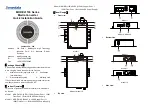
Dolby Surround Mixing Manual
Dolby Surround Mixing Manual
5-1
5-1
Chapter 5
Chapter 5
Mixing Techniques
Mixing Techniques
5.1
5.1
Announcers
Announcers and
and Dialogue
Dialogue
Traditionally, dialogue is placed only in the
Traditionally, dialogue is placed only in the Center speaker to tie the on-screen sounds to the
Center speaker to tie the on-screen sounds to the
picture. When a Center speaker is used, all
picture. When a Center speaker is used, all center-panned dialogue appears to come from the
center-panned dialogue appears to come from the
screen regardless of the listener’s position. If the dialogue comes from the Left
screen regardless of the listener’s position. If the dialogue comes from the Left or Right speakers,
or Right speakers,
the stereo image differs depending on the listener’s position. This is highly
the stereo image differs depending on the listener’s position. This is highly undesirable. It does
undesirable. It does
not bar voices from the other channels, but generally
not bar voices from the other channels, but generally only effects or incidental voices should be
only effects or incidental voices should be
in any channel other than center.
in any channel other than center.
5.2
5.2
Interior
Interior Effects
Effects
Interior sound effects come from all four channels and appear to
Interior sound effects come from all four channels and appear to surround the listener. Wind
surround the listener. Wind
noise, crowds, and other general ambient sounds are included within the
noise, crowds, and other general ambient sounds are included within the mix to give a sense of
mix to give a sense of
realism. Effects and ambient sounds will normally appear in
realism. Effects and ambient sounds will normally appear in the Left, Right, and Surround
the Left, Right, and Surround
channels. It is common to use Stereo
channels. It is common to use Stereo ambiance that is panned left and
ambiance that is panned left and Surround for the Left
Surround for the Left
channel of the source and Right and S
channel of the source and Right and Surround for the Right channel of the source. The resulting
urround for the Right channel of the source. The resulting
sound surrounds the listener, yet still has a front stereo i
sound surrounds the listener, yet still has a front stereo i mage. The amount of Surround channel
mage. The amount of Surround channel
signal added determines how far back the l
signal added determines how far back the l istener is in relation to the
istener is in relation to the front sounds. More
front sounds. More
surround level produces an image that sounds further back in the
surround level produces an image that sounds further back in the room.
room.
Sometimes only a mono element is
Sometimes only a mono element is available when a surround effect is desired. In this case,
available when a surround effect is desired. In this case, put
put
the signal in both the Center
the signal in both the Center and Surround channels. This is commonly known as a 2-4 punch.
and Surround channels. This is commonly known as a 2-4 punch.
With equal application to both Center and
With equal application to both Center and Surround, the sound appears to come from all four
Surround, the sound appears to come from all four
channels. Stereo reverb can also give a
channels. Stereo reverb can also give a mono sound element a slightly wider image. Simply
mono sound element a slightly wider image. Simply
apply the reverb effect to the Left
apply the reverb effect to the Left and Right channels while applying the original dry
and Right channels while applying the original dry signal to
signal to
the Center and
the Center and Surround channels.
Surround channels.
Another effective technique is to and assign the signal to
Another effective technique is to and assign the signal to the Left channel and add about
the Left channel and add about 8
8
milliseconds delay of the same signal to the
milliseconds delay of the same signal to the Right channel. This may or may not
Right channel. This may or may not produce
produce
acceptable results, depending on the program material.
acceptable results, depending on the program material.
5.3
5.3
Positioning
Positioning of
of the
the Stereo
Stereo Image
Image
The Center speaker in a Dolby
The Center speaker in a Dolby
®
®
Surround system produces stereo imaging that is slightly
Surround system produces stereo imaging that is slightly
different than that of a tw
different than that of a two speaker stereo system. Most music engineers find this distracting at
o speaker stereo system. Most music engineers find this distracting at
first, but adjust quickly. Those who mix motion picture sound feel
first, but adjust quickly. Those who mix motion picture sound feel comfortable, as do those
comfortable, as do those
music engineers who own a home theater system. The
music engineers who own a home theater system. The most noticeable difference in the stereo
most noticeable difference in the stereo
image is that the perceived
image is that the perceived image tends to be narrower when a
image tends to be narrower when a Center speaker is used. Because
Center speaker is used. Because
most music mixes contain significant amounts of Center channel information, we are
most music mixes contain significant amounts of Center channel information, we are used to
used to
hearing a phantom image produced by the Left
hearing a phantom image produced by the Left and Right speakers. Since all of this
and Right speakers. Since all of this information
information















































